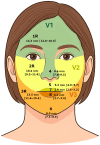Establishment of Norms for Facial Discriminative Sensitivity in Healthy Women Aged 45-60 Years: A Reference Framework
- PMID: 40725577
- PMCID: PMC12295248
- DOI: 10.3390/jcm14144884
Establishment of Norms for Facial Discriminative Sensitivity in Healthy Women Aged 45-60 Years: A Reference Framework
Abstract
Background/Objectives: In the context of facial surgery, particularly reconstructive procedures, sensory recovery is a critical yet often underexplored aspect of functional rehabilitation. Sensory-motor recovery can be considered a key marker of integration following reconstructive surgery. Among sensory modalities, discriminative sensitivity is typically the last to recover, making its evaluation particularly relevant. While established norms for hand sensitivity exist in the literature, there is a paucity of data regarding facial sensitivity. The objective of this study was to evaluate the discriminative sensitivity of the face in a population of healthy women aged 45-60 years. Methods: A total of 20 healthy women were included between January and March 2013. Participants had no history of facial pathologies or trauma. Discriminative sensitivity was measured using the Disk-Criminator™ device across eight facial zones. A detailed mapping of the tested areas was performed. Data obtained were compared with the existing literature. Statistical analyses included Shapiro-Wilk tests for normality, followed by Student's t-tests for group comparisons. To account for small sample size and verify robustness, non-parametric Mann-Whitney U tests were also performed. Adjustment for multiple comparisons was applied using the Bonferroni correction (adjusted α = 0.0125). Results: The mean age of participants was 52.3 years (±4.0 years). Discrimination threshold values ranged from 2.9 to 14.3 mm. Comparison with existing studies showed no significant age-related differences in zone 2R (cheek) and zone 8 (lower lip), suggesting stable sensitivity in these regions across adulthood. However, a significant decline in sensitivity with age was observed only in zone 1R (forehead), with a p-value < 0.001 after Bonferroni correction. Conclusions: We established a reference framework for cutaneous discriminative sensitivity across eight facial zones. These norms can serve as a baseline for the assessment and monitoring of patients with facial pathologies. Furthermore, our findings contribute to a better understanding of age-related sensory changes.
Keywords: aging and sensory perception; facial discriminative sensitivity; normative values; sensory recovery; two-point discrimination (TPD) test.
Conflict of interest statement
The authors declare no conflicts of interest.
Figures





References
-
- Meyer R.A., Rath E.M. Sensory Rehabilitation after Trigeminal Nerve Injury or Nerve Repair. Oral Maxillofac. Surg. Clin. N. Am. 2001;13:365–376. doi: 10.1016/S1042-3699(20)30150-3. - DOI
LinkOut - more resources
Full Text Sources

